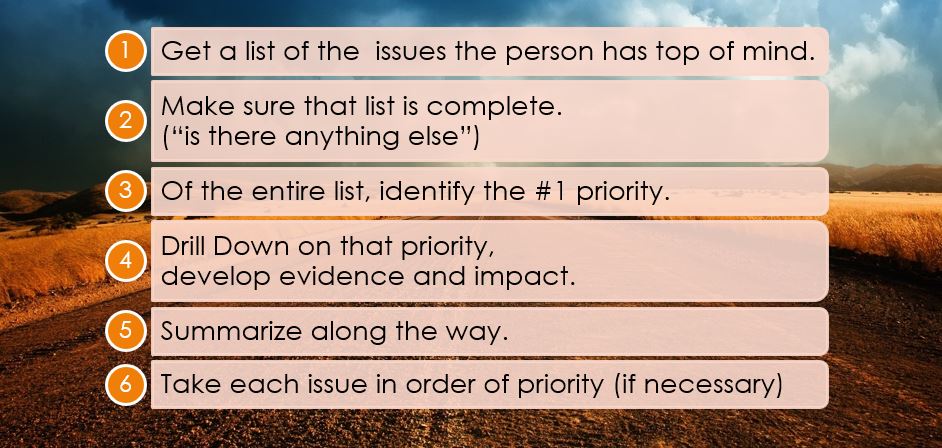
A powerful question creates a new understanding. It’s either the unlock to truly understand another person, or it opens them up to understand something new. Asking the right question is vital in gathering requirements, understanding customer needs, helping shape out plans, as well as holding people to account. Get the question right, and it brings better understanding. Asking a question badly or the wrong question can create distance, distrust, and mis-understanding.
Below are some ideas on the art of good (and bad) questions, plus a useful technique on structuring a typical data gathering, or interview session with customers.
Bad Questions
We’ve all been on the receiving end of bad questions – ones that close down a conversation, confuse or make us feel manipulated. Examples include:
- Leading Questions. You assume the answer, so you lead them to agree with you. (And most people try to please, or follow the path of least resistance) “How late do you think that the project will deliver?”. This assumes that the project will certainly not be completed on time
- Guessing (or mind reading) This is where you assume you know what the other person means, or that they need to read your mind. Often the other person’s definition does not match yours. “What kind of CMS do you need?” (assumes they need a CRM, and they know what one is (CMS = content management system, or carrier management system, depending on context).
- The Presumptive Yes – a question that assumes one answer, and makes it hard to say the opposite without an argument “You do think I’m right about this product, don’t you?”. “Shall we all approve Option 2?” is more likely to get a positive response than “Do you want to approve option 2 or not?”.
- The Non-question – a statement that is really a criticism “Why didn’t you put out the trash again?”
- The Aggressive Why – the word ‘why’ is rarely used to understand, but mostly used to get the other person to explain their ‘stupid’ actions “Why didn’t you call them before?”
Breaking Bad Questions (Good Questions)
to break this we need to create the atmosphere for understanding. Carl Alasko, in his book, “Say this, not that” talks about two elements:
- Mutual Respect. So this is about building rapport which includes:
- Asking permission to ask a question
- Clean and Open questions. Clean questions are ones that allow the other person to open up without assuming or accidentally influence time. For example “When did you break the system?” is not clean. It assumes you broken something. “What happened before the system broke?” is non-judgement and allows a fuller answer. Open questions are ones that don’t demand Yes/No or a specific fact. There are times for these – for example, to get data, but usually they don’t open conversation.
- the Powerful Pause. Real answers take time to think about, so just not saying something encourages the other to fill the silence. Hanging questions with pause can also draw this out – “Tell me more ….” or “Then What Happened”
- Mutual Purpose.
-
- Softening Statement. Before asking a question, it’s always worth giving context, explaining purpose, or just signposting the question so the subconscious can prepare to find the answers. If the interviewee understands the reason for the question, then they may be more willing to open up.
- How not Why. You may have heard of the ‘Five Whys’ to drill down on core issues. This has a purpose, but the word ‘Why’ can make the person feel accused. It takes us back to childhood questioning ‘why did you do that…’. Alternatively ‘How did this happen’ can achieve this same purpose, or ‘For what reason did ….’.
- “…for you?”. This is another softening tag, and allows the interviewee comfort that there isn’t a ‘right answer’ to the question. It also makes it personal, rather than an intellectual/theoretical answer. “What does CMS mean, for you?”, or “What’s important about the application, for you?”.
-
6 Steps FOr Successful interviewing
In the early 2000s, I had the fortune to be trained by Mahan Khalsa (author of ‘Let’s get real, or lets’ not play’) about a six step approach to structuring a really productive interview. It helps drill down to the core issues, and get the information about the important ones.

What if They Won’t Answer the question
When someone doesn’t answer the question, it may be that they don’t feel safe to answer or they don’t understand the question.
- Repeat the question – “Sorry, I don’t think you answered the questions. What budget do you think this project should have?”
- Ask again later
- Rephrase the question – “In terms of company investment. What would be a sensible figure for the company to spend on this project?”
- Change the tone – “Would you care to speculate how much a project like this might cost?”
- Name the game – “It sounds like you are avoiding the question. What’s stopping you from estimating the cost of this project?”
- Ask about underlying issues. This assumes there might be underlying reasons for not answering the question. Perhaps its confidence, or they’ve suffered from giving unrealistic expectations in the past. “I’m sensing something deeper. Tell me about why you feel unable to give me an answer?”
The closing Question
How often do you find that you leave a meeting, and only afterwards discover there’s an issue that wasn’t raised but was the real answer. A useful close for any interview or data gathering is to ask
“is there anything else?”
Or variants “Is there anything we haven’t discussed that I should be aware of?”, or “are there any other points that are important that aren’t on the list”.
